Contents
- Summary
- Historical Context
- Themes
- Cinematography
- Key Symbols
- Sample Essay Topics
- Essay Topic Breakdown
- Resources
Rear Window is usually studied in the Australian curriculum under Area of Study 1 - Text Response. For a detailed guide on Text Response, check out our Ultimate Guide to VCE Text Response.
1. Summary
When most people think of Hitchcock, it’s the screeching violins from Psycho that first come to mind. Whilst he is indeed known for his hair-curling thrillers, Rear Window is a slightly subtler film which focuses not on a murderer at large, but rather a crippled photographer who never even leaves his apartment.
Our protagonist L.B. ‘Jeff’ Jefferies is portrayed by James Stewart, who was known at the time for portraying cowboys in various Western films as well as starring in an earlier Hitchcock film Rope. After breaking his leg after a racing accident, Jeff begins to spy on his neighbours, one of whom he suspects of having committed a murder.
Despite some initial misgivings, his insurance nurse Stella (Thelma Ritter) and lover Lisa (Grace Kelly) also come to share his suspicions and participate in his spying. Their contributions ultimately allow the mystery to be solved.
Intertwined with this mystery is also the rather complex story of Jeff and Lisa’s relationship. Jeff on one hand resembles the ‘macho’ men of action whom Stewart is very accustomed to playing. On the other hand, Kelly portrays a character much like herself, a refined and elegant urbanite whose lifestyle inherently clashes with that of an action photographer.
Hitchcock ultimately resolves both of these storylines in the film’s denouement.
2. Historial Context
Before getting into the nitty-gritty of the film, it is crucial to understand a bit about its historical context. As with any other text, the social conditions at the time of Rear Window’s release in 1954 inform and shape the interactions and events of the film.
Released in the post-war period, the film is undoubtedly characterised by the interpersonal suspicion which defined the era. In particular, there was a real fear in America of Communist influences and Soviet espionage - so much so that a tribunal was established, supposedly to weed out Communists despite a general lack of evidence. This practice of making accusations without such evidence is now known as the McCarthyism, named after the senator behind the tribunal.
The film undoubtedly carries undertones of this, particularly in Jeff’s disregard for his neighbours’ privacy and his unparalleled ability to jump to conclusions about them. During this era, people really did fear one another, since the threat of Communism felt so widespread. Jeff’s exaggerated interpretations of his neighbours’ actions lead him to an irrational sense of suspicion, which is in many way the basis of the entire film.
At the same time, the 1950s saw a boom in photojournalism as a legitimate profession. To some extent, this was fuelled by the heyday of Life magazine (an American weekly, as well-known then as Time magazine is today). This publication was almost entirely photojournalistic, and one of their war photojournalists, Robert Capa, is actually the basis of Jeff’s character. This explains the prevalence of cameras in his life, as well as his ability to emotionally distance himself from those whom he observes through the lens.
Another crucial historical element is the institution of marriage, and how important it was to people during the 1950s. It was an aspiration which everyone was expected to have, and this is reflected statistically - only 9.3% of homes then had single occupants (as opposed to around 25% today). People also tended to marry at a younger age, generally in their early 20s.
Conversely, divorce was highly frowned upon, and once you were married, you would in general remain married for the rest of your life. In particular, divorced women suffered massive financial difficulties, since men, as breadwinners, held higher-paying jobs, and women were only employed in traditionally female roles (e.g. secretaries, nurses, teachers, librarians). Seen in this light, we can understand Lisa’s overwhelming desire to marry and settle down with Jeff. The importance of marriage is also evident in the lives of Jeff’s neighbours; Miss Torso’s 'juggling [of the] wolves', and Miss Lonelyheart’s depression both reflect this idea.
3. Themes
Combining a basic understanding of the film’s plot, as well as our knowledge of its history, we can begin to analyse some of the themes that emerge.
Possibly the central tenet of the film is the big question of privacy. Even in today’s society, the sanctity of privacy is an important concept; every individual has a right to make their own choices without having to disclose, explain or justify all of them. The character of Doyle says almost these exact words:
'That’s a secret and private world you’re looking into out there. People do a lot of things in private that they couldn’t possibly explain in public'
The tension that Hitchcock draws upon is this other idea of public responsibility, or civic duty - that is, the need to uphold the peace and protect one’s fellow citizens from harm. These ideas clash in Rear Window, as fulfilling this civic responsibility (which for Jeff means privately investigating Thorwald) means that Thorwald’s right to privacy gets totally thrown out the window. So to speak.
Evidently, this is a major moral dilemma. If you suspect that someone has committed murder, does this give you the right to disregard their privacy and surveil them in this way? While the film doesn’t give a definite answer (and you won’t be required to give a definite answer), Hitchcock undoubtedly explores the complexity of this question. Even Jeff has misgivings about what he’s seeing:
'Do you suppose it’s ethical to watch a man with binoculars, and a long-focus lens—until you can see the freckles on the back of his neck, and almost read his mail? Do you suppose it’s ethical even if you prove he didn’t commit a crime?'
In some ways, the audience is also positioned to reflect on this question, and in particular, reflect on the paranoia that characterised and defined the McCarthy era.
Somewhat separate to these questions is the romance between Jeff and Lisa, since Hitchcock seems to keep the thriller storyline and the romance storyline separate for a large part of the film. Their contrasting lifestyles and world views present a major obstacle in the fulfilment of their romance, and the murder mystery both distracts and unites them. Hitchcock further alludes to the question of whether marriage will be able to settle those differences after all - a major example is the following scene, in which Lisa not only reveals her discovery of Mrs Thorwald’s ring, but also expresses a desire for Jeff to ‘put a ring on it’ as well:

4. Cinematography
It’s impossible to study a Hitchcock film without considering how he impacted and manipulated its storytelling. The cinematographic techniques employed in Rear Window are important ways of shaping our understanding of the film, and Hitchcock uses a wide array of visual cues to communicate certain messages.
Lighting is one such cue that he uses a lot - it is said that at certain points in filming, he had used every single light owned by the studio in which this film was shot. In this film, lighting is used to reveal things: when the lights are on in any given apartment, Jeff is able to peer inside and watch through the window (almost resembling a little TV screen; Jeff is also able to channel surf through the various apartments - Hitchcock uses panning to show this).
On the contrary, a lack of lighting is also used to hide things, and we see Thorwald utilise this at many stages in the film. Jeff also takes advantage of this, as he often sits in a position where he is very close to being in the shadows himself; if he feels the need, he is able to retreat such that he is fully enshrouded. Low-key lighting in these scenes also contributes to an overall sense of drama and tension.
Another handy visual cue is the cross-cut, which is an example of the Kuleshov effect. The Kuleshov effect is an editing technique whereby a sequence of two shots is used to convey information more effectively than just a single shot. Specifically, the cross-cut shifts from a shot of a person to a second shot of something that this person is watching.
We see this often, particularly when Jeff is responding to events in the courtyard; Hitchcock uses this cross-cut to immediately show us what has caused Jeff’s response. This visual cue indicates to viewers that we are seeing what Jeff is seeing, and is one of the few ways that Hitchcock helps audiences assume Jeff’s point-of-view in key moments.
Similarly, Hitchcock also uses photographic vignetting to merge our perspectives with Jeff’s - in certain shots, we see a fade in clarity and colour towards the sides of a frame, and this can look like a circular shadow, indicating to us that we are seeing something through a telescope or a long-focus lens.

Interestingly, a vignette is also a short, descriptive scene that focuses on a certain character and/or idea to provide us with insights about them - in this sense, it’s also possible to say that Jeff watches vignettes of his neighbours. Since this word has two meanings, you must be careful about which meaning you’re referring to.
______
By the way, to download a PDF version of this blog for printing or offline use, click here!
______
5. Key Symbols
As with any other text, it’s important to consider some of the key symbols that Hitchcock draws upon in order to tell his story. That being said, one of the benefits of studying a film is that these symbols tend to be quite visual - you are able to see these recurring images and this may make them easier to spot. We’ll be going through some of these key images in the final part of this guide.
One of the first symbols we see is Jeff’s broken leg, which is propped up and completely covered by a cast, useless for the time being. Because he has been rendered immobile by his leg, readers can infer from this symbol that he is also incapable of working or even leaving his apartment, let alone solving a murder mystery. The broken leg is in this sense a symbol of his powerlessness and the source of much of his discontent.
Another interpretation of the broken leg however, is that it represents his impotence which on one hand is synonymous for powerlessness or helplessness, but is on the other hand an allusion to his apparent inability to feel sexual desire. Being constantly distracted from Lisa by other goings-on in the courtyard definitely supports this theory. All in all, Jeff’s broken leg represents some compromise of his manhood, both in the sense that he cannot work in the way that a man would have been expected to, but also in the sense that he is unable to feel any attraction towards Lisa, even as she tries her best to seduce him.
Conversely, Jeff’s long-focus camera lens is a symbol of his passive male gaze, which is more or less the only thing he can do in his condition. It is the main means through which he observes other people, and thus, it also symbolises his voyeuristic tendencies - just as his broken leg traps and inhibits him, his camera lens transports him out of his own apartment and allows him to project his own fears and insecurities into the apartments of his neighbours, watching them for entertainment, for visual pleasure.
In this latter sense, the camera lens can also be understood as a phallic symbol, an erection of sorts. It highlights Jeff’s perverted nature, and the pleasure he derives from the act of observing others. Yikes.

On the other hand, Lisa’s dresses underscore the more positive parts of her character. Her initial wardrobe represents her elegance and refinery whilst also communicating a degree of incompatibility with Jeff. However, as she changes and compromises throughout the film, her wardrobe also becomes much more practical and much less ostentatious as the film wears on, until she is finally wearing a smart blouse, jeans and a pair of loafers. The change in her wardrobe reflects changes in her character as well.
Finally, the wedding ring of Mrs Thorwald is hugely significant; wedding rings in general represent marriage and commitment, and are still very important symbols that people still wear today. Specifically, Mrs Thorwald’s ring means a couple of things in the context of the film - it is firstly a crucial piece of evidence (because if Mrs Thorwald was still alive, she would probably still be wearing it) and it is also a symbol through which Lisa can express a desire for stability, commitment and for herself to be married.
There’s definitely plenty to talk about with Hitchcock’s Rear Window, and I hope these points of consideration help you tackle this film!
Test your film technique knowledge with the video below:
Ready to start writing on Rear Window? Watch the Rear Window Essay Topic Breakdown:
6. Sample Essay Topics
- In Rear Window, Hitchcock suggests that everybody can be guilty of voyeurism. Do you agree?
- Jeff’s attempts to pursue justice are entirely without honour. To what extent is this true?
- In the society presented in Rear Window, Jeff has more power and agency than Lisa in spite of his injury. Do you agree?
- Discuss how the opening sequence sets up later themes and events in Rear Window.
- 'Of course, they can do the same thing to me, watch me like a bug under glass if they want to.' Hitchcock’s Rear Window argues that it is human nature to be suspicious. To what extent do you agree?
- Explore the role of Jeff’s courtyard neighbours in the narrative of Rear Window.
- Jeff and Lisa’s roles in Rear Window, as well as that which they witness, reflect the broader societal tensions between the sexes of the time. Discuss.
- 'I’m not much on rear window ethics.' The sanctity of domestic privacy supersedes the importance of public responsibility. Is this the message of Rear Window?
- Marriage lies at the heart of Alfred Hitchcock’s Rear Window. Discuss.
- Hitchcock’s Rear Window explores and ultimately condemns the spectacle made of human suffering. Is this an accurate reflection of the film?
- Rear Window argues that it is more important to be right than to be ethical. Do you agree?
- 'To see you is to love you.' What warnings and messages regarding attraction are offered by Hitchcock’s Rear Window?
- In Rear Window, women are merely objects of a sexist male gaze. To what extent do you agree?
- In what ways do Hitchcock’s cinematic techniques enhance his storytelling in Rear Window?
- 'When they’re in trouble, it’s always their Girl Friday that gets them out of it.' Is Lisa the true heroine of Rear Window?
Now it's your turn to give these essay topics a go! In our ebook A Killer Text Guide: Rear Window, we've take 5 of these essay topics and show you our analysis, brainstorm and plan for each individual topic. We then write up full A+ essays - all annotated - so that you know exactly what you need to do to replicate a 50 study scorer's success!.
7. Essay Topic Breakdown
Whenever you get a new essay topic, you can use LSG’s THINK and EXECUTE strategy - a technique to help you write better VCE essays. This essay topic breakdown will focus on the THINK part of the strategy. If you’re unfamiliar with this strategy, then check it out in How To Write A Killer Text Response because it’ll dramatically enhance how much you can take away from the following essays and more importantly, your ability to apply this strategy in your own writing.
Within the THINK strategy, we have 3 steps, or ABC. These ABC components are:
Step 1: Analyse
Step 2: Brainstorm
Step 3: Create a Plan
THINK
Film technique-based prompt:
Hitchcock’s use of film techniques offers an unnerving viewing experience. Discuss.
Step 1: Analyse
While we should use film techniques as part of our evidence repertoire in each essay, this particular type of essay prompt literally begs for it. As such, I’d ensure that my essay has a greater focus on film techniques (without concerning myself too much over inclusion of quotes; the film techniques will act as a replacement for the quotes).
Step 2: Brainstorm
Since the essay prompt is rather open-ended, it is up to us to decide which central themes and ideas we’d like to focus on. By narrowing down the discussion possibilities ourselves, we’ll 1) make our lives easier by removing the pressure to write about everything, and 2) offer teachers and examiners a more linear and straightforward approach that will make it easier for them to follow (and give you better marks!).
The ‘unnerving viewing experience’ is present throughout the entire film, so my approach will be to divide up each paragraph into start of the film, middle of the film and end of the film discussions. This will help with my essay’s coherence (how well the ideas come together), and flow (how well the ideas logically progress from one to another).
Step 3: Create a Plan
Contention: Through a diverse range of film techniques, Hitchcock instils fear and apprehension into the audience of Rear Window.
P1: The opening sequence of Rear Window employs various film techniques to immediately establish underlying tension in its setting.
P2: Through employing the Kuleshov effect in the strategically cut scene of Miss Lonelyhearts’ attempted suicide, Hitchcock adds to the suspenseful tone of the film by developing a guilty voyeur within each viewer.
P3: In tandem with this, Hitchcock ultimately adds to the anxiety of the audience by employing lighting and cross-cutting techniques in the climax scene of the plot, in which an infuriated Thorwald attempts to enter Jeff’s apartment.
If you find this helpful, then you might want to check out our A Killer Text Guide: Rear Window ebook, which has all the information and resources you need to succeed in your exam, with detailed summaries and background information, as well as a detailed analysis of all five essay prompts!
8. Resources
Download a PDF version of this blog for printing or offline use
How To Write a Rear Window Film Analysis
Rear Window: How Does Its Message Remain Relevant Today?
The Ultimate Guide to VCE Text Response
How To Write A Killer Text Response (ebook)
How To Embed Quotes in Your Essay Like a Boss

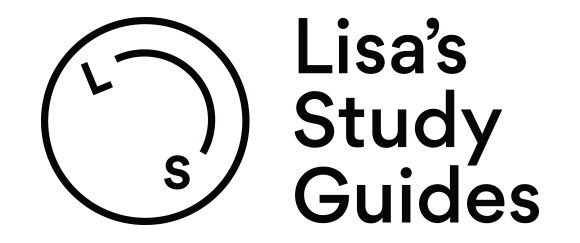



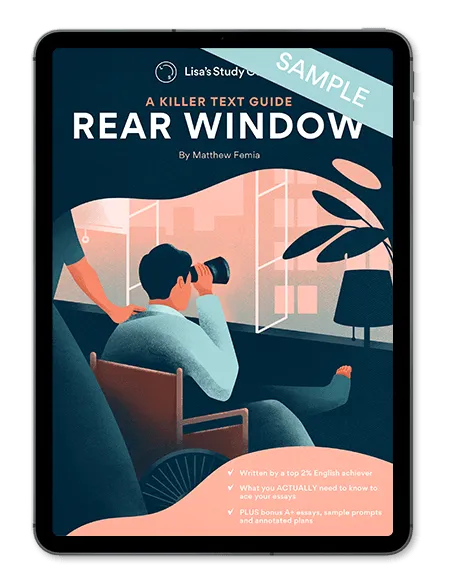











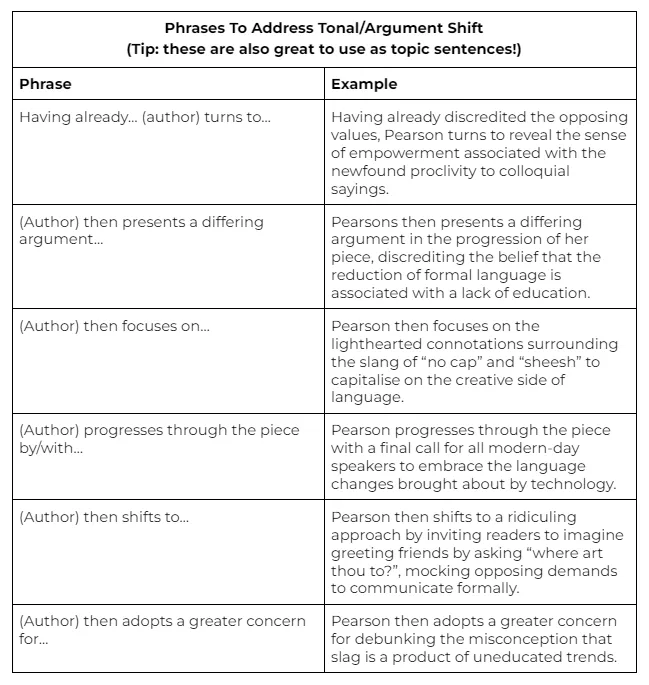

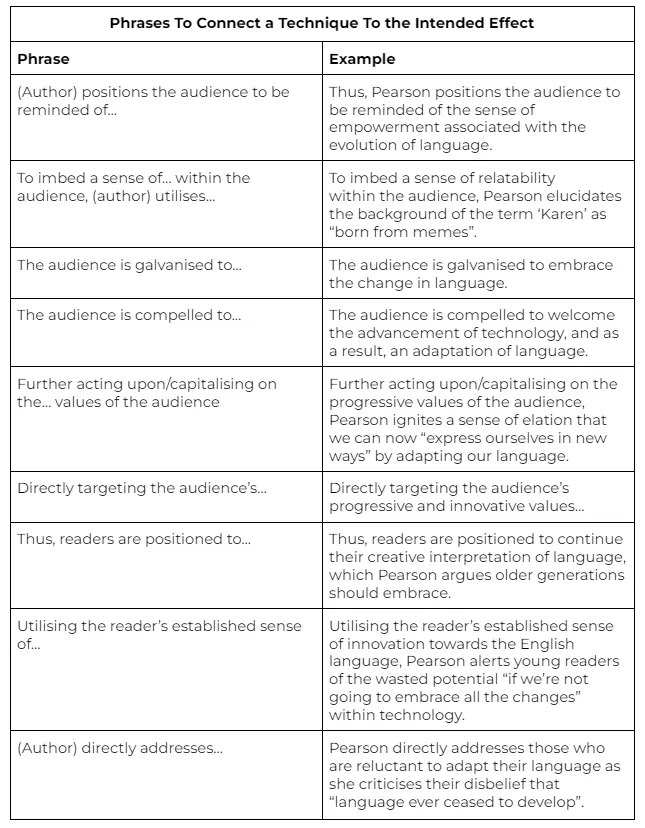
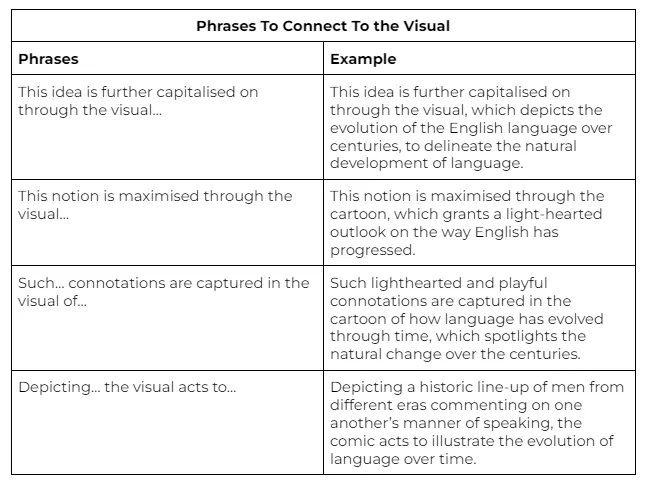
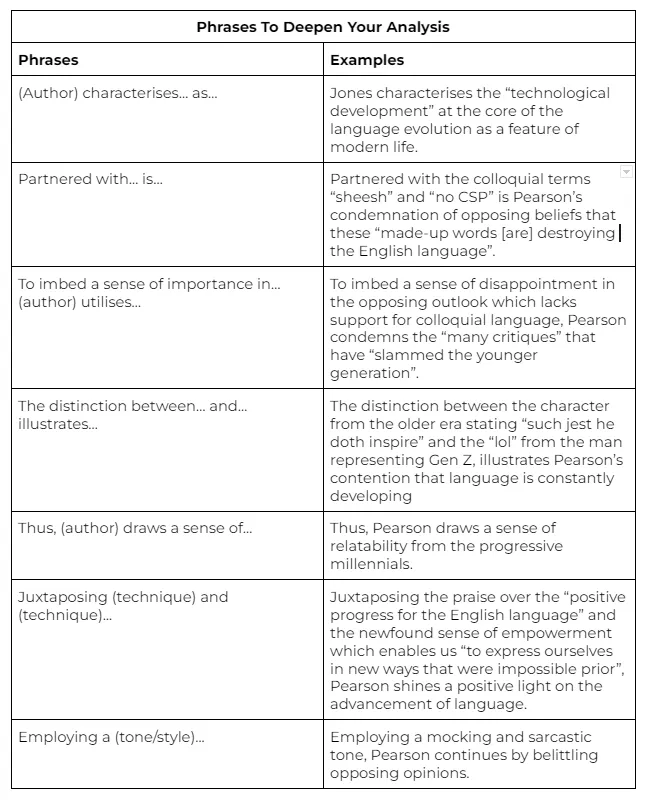

.jpg)